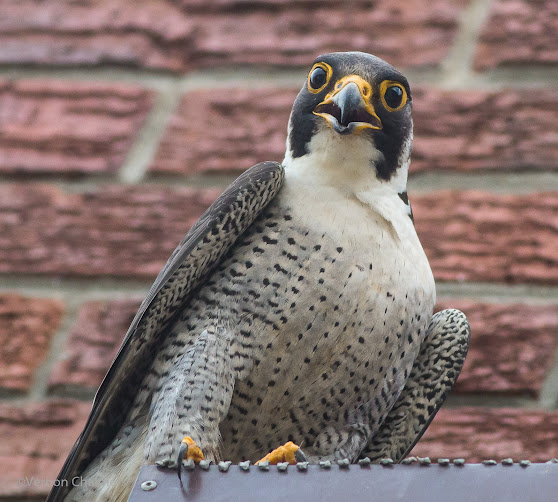The Peregrine Falcon Cited by Many Sources as the Fastest Flying Bird in the World
What Bird is the Fastest Bird in the World?
 |
| Fast Peregrine Falcon outside my window : Arnhem Milnerton, Cape Town |
Image: Peregrine falcon swooped into a dive high outside my bedroom window. (Canon 7D Mark II / EF 400mm f/5.6L USM Lens)
 |
| Fast Peregrine Falcon flying straight at me : Arnhem Milnerton, Cape Town |
Image: Peregrine falcon flying directly at me while watching him through my bedroom window. (Canon 7D Mark II / EF 400mm f/5.6L USM lens)
Peregrine Falcon as Fasted Bird Speed Report >>
Returning Peregrine Falcon to Milnerton, Woodbridge Island >>
Peregrine Falcon Speed Measurement / Sources:
Measuring a bird or animal speed is by no means an easy and (not always) an accurate measurement, but going through various online sources it seems to be a definite agreement that the Peregrine falcon with a top diving airspeed of +- 300 km/h / 186 mph is the fastest bird.Who would win gold in the bird Olympics?
 |
| Peregrine Falcon Outside My Window : Arnhem, Milnerton |
- The Peregrine Falcon achieves its incredible speed during high-speed dives, or "stoops," when it is hunting prey. In a dive, it can reach speeds of over 240 miles per hour (386 kilometers per hour).
- The Peregrine Falcon has several adaptations that contribute to its speed, including streamlined aerodynamics, powerful flight muscles, and a specialized respiratory system that allows for efficient oxygen intake during high-speed pursuits.
- When hunting, the Peregrine Falcon climbs to a great height and then goes into a rapid, steep dive to strike its prey. It tucks its wings close to its body during the dive, minimizing air resistance.
- Peregrine Falcons are found on every continent except Antarctica. They are adaptable birds and can be seen in a variety of habitats, from urban areas to mountainous regions.
- Their diet primarily consists of other birds, and their speed is a crucial asset when hunting agile prey in the air. Peregrine Falcons are known for preying on birds in flight, often striking them mid-air.
- The Peregrine Falcon faced significant population declines in the mid-20th century due to the use of certain pesticides, particularly DDT. Conservation efforts, including the banning of DDT and the implementation of breeding programs, have led to the recovery of Peregrine Falcon populations in many regions.
- Peregrine Falcons build nests on cliffs, ledges, or tall structures such as buildings and bridges. They are known for their courtship displays, which involve aerial acrobatics.
- There are several subspecies of Peregrine Falcons, adapted to different regions and habitats. Some subspecies are migratory, covering vast distances during their migrations.
The Peregrine Falcon: Fastest Bird in the World
"The epitome of speed and precision in the avian world! These incredible birds can reach speeds of over 240 miles per hour (386 kilometers per hour) when they dive for prey, making them the fastest animals on the planet. It's no wonder they're often referred to as "nature's fighter jets."
Here are a few fascinating facts about Peregrine Falcons:
- Habitat: They are found on every continent except Antarctica, thriving in diverse environments from urban skyscrapers to remote mountain ranges.
- Diet: Their diet primarily consists of other birds, which they hunt with incredible agility and speed.
- Reproduction: They typically nest on high cliffs or tall buildings, laying 3-4 eggs per clutch.
- Conservation: Peregrine Falcons faced a steep decline in the mid-20th century due to pesticide use, but conservation efforts have helped their populations recover significantly." (Source: Microsoft Copilot 2025)
 |
| Peregrine Falcon watching me : Arnhem Milnerton, Cape Town |
The Peregrine falcon is not your average avian predator. When hunting, this remarkable bird will fly to great heights, then dive bomb its prey abruptly at speeds of up to 242 mph.
Vernon Chalmers Photography Training Intaka Island | Kirstenbosch Garden | Woodbridge Island